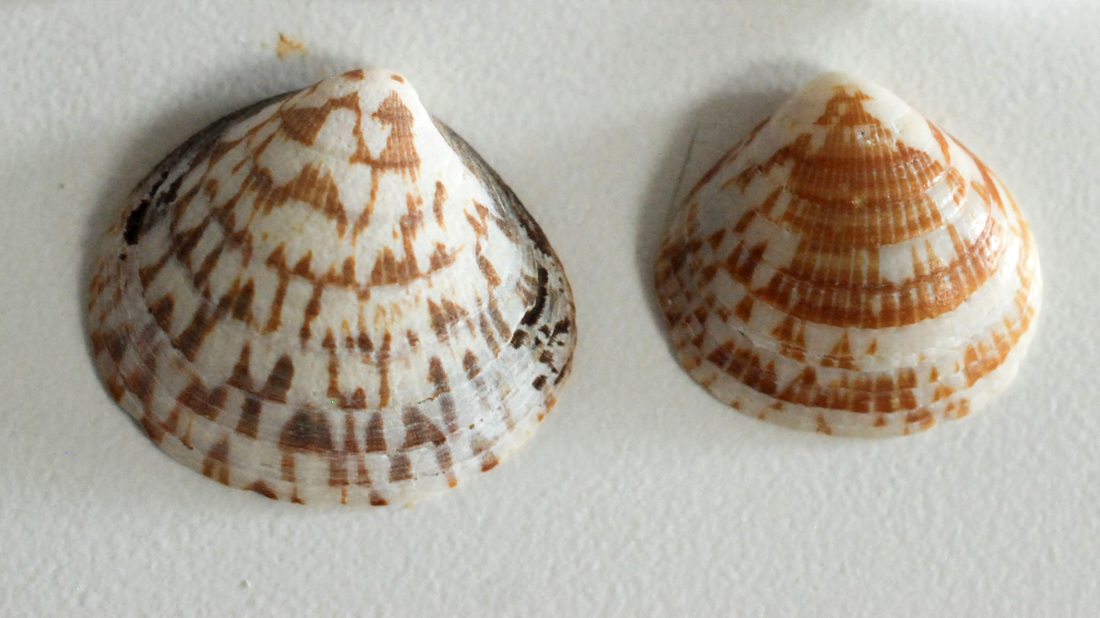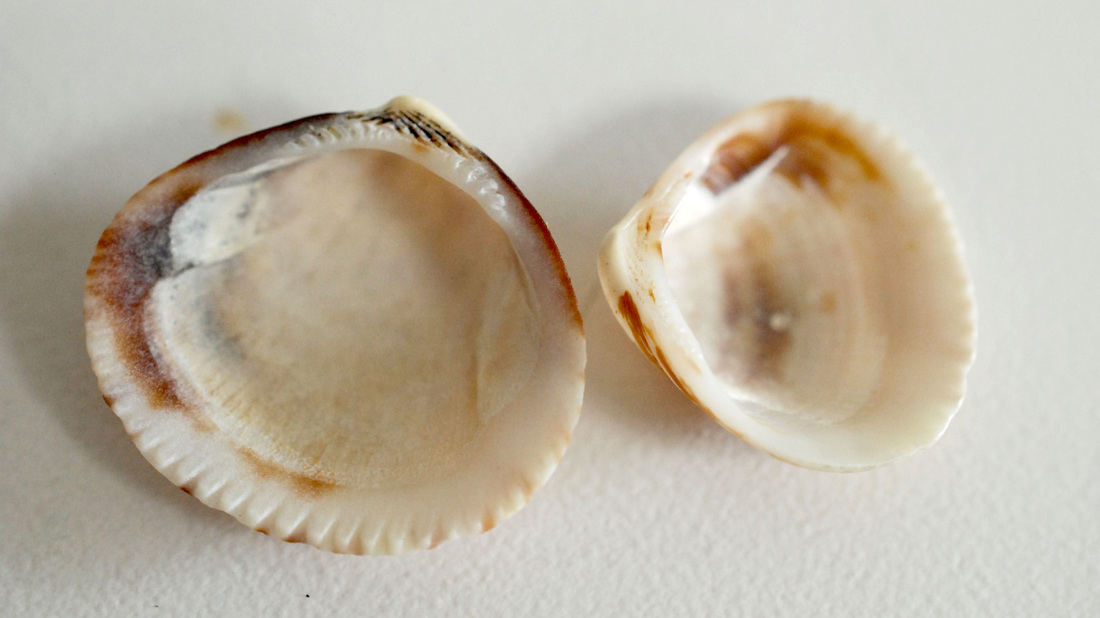Western bittersweet • Glycymeris septentrionalis
Valves from two different western bittersweet shells in the Hakai Institute shell specimen collection on Calvert Island. Photos by Kelly Fretwell.
Identification
Like other bittersweets, this clam's shell is thick and is arched by the hinge. The shell is light brown to white, and is often marked with dark zig-zag patterns. The radial ribs are flattened and often worn smooth, and the periostracum may be worn away but present around the edges of the shell exterior. The inside ventral (opposite the hinge) margin of the shell valves has numerous teeth, and the inner hinge margin has 15-16 small teeth. The interior of the shell may be stained with yellow and purplish-brown. The shell gets to 4.5 cm long.
Habitat & Range
The western bittersweet is found buried in sand or gravel sediments, in the intertidal and subtidal to depths of 400 m. Its range extends from the northeast of the Bering Sea in Alaska to northern Mexico.
Similar Species
This clam may be initially mistaken for the Pacific littleneck clam (Protothaca staminea) or the Japanese littleneck clam (Venerupis phillipinarum) however the two littlenecks tend to have more prominent radial ribs and concentric ridges. If unsure, check the inner margins of the shell valves: the Japanese littleneck has no teeth on the inside of the inner ventral margin, and the Pacific littleneck has many very fine teeth there but no teeth along the hinge margin. Another species of bittersweet is rarely found in the Pacific Northwest.
iNaturalist
https://www.inaturalist.org/taxa/479438-Glycymeris-septentrionalis
Like other bittersweets, this clam's shell is thick and is arched by the hinge. The shell is light brown to white, and is often marked with dark zig-zag patterns. The radial ribs are flattened and often worn smooth, and the periostracum may be worn away but present around the edges of the shell exterior. The inside ventral (opposite the hinge) margin of the shell valves has numerous teeth, and the inner hinge margin has 15-16 small teeth. The interior of the shell may be stained with yellow and purplish-brown. The shell gets to 4.5 cm long.
Habitat & Range
The western bittersweet is found buried in sand or gravel sediments, in the intertidal and subtidal to depths of 400 m. Its range extends from the northeast of the Bering Sea in Alaska to northern Mexico.
Similar Species
This clam may be initially mistaken for the Pacific littleneck clam (Protothaca staminea) or the Japanese littleneck clam (Venerupis phillipinarum) however the two littlenecks tend to have more prominent radial ribs and concentric ridges. If unsure, check the inner margins of the shell valves: the Japanese littleneck has no teeth on the inside of the inner ventral margin, and the Pacific littleneck has many very fine teeth there but no teeth along the hinge margin. Another species of bittersweet is rarely found in the Pacific Northwest.
iNaturalist
https://www.inaturalist.org/taxa/479438-Glycymeris-septentrionalis
References
Harbo, R. M. (1997) Shells & Shellfish of the Pacific Northwest. Madeira Park, BC: Harbour Publishing. P. 133-134.
Lamb, A., and Hanby, B. (2005). Marine Life of the Pacific Northwest [electronic version]. Madeira Park, BC: Harbour Publishing.
Authors and editors of page
Kelly Fretwell (2017).
Harbo, R. M. (1997) Shells & Shellfish of the Pacific Northwest. Madeira Park, BC: Harbour Publishing. P. 133-134.
Lamb, A., and Hanby, B. (2005). Marine Life of the Pacific Northwest [electronic version]. Madeira Park, BC: Harbour Publishing.
Authors and editors of page
Kelly Fretwell (2017).






